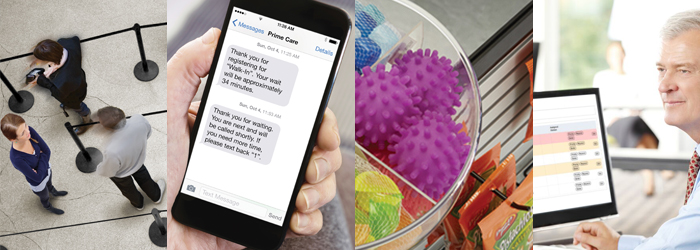
Maneje el arrepentimiento con una fila de espera de una sola línea
The outcome of a purchase remains in limbo as people wait their turn in the checkout line. And when the feeling of impatience wins over, reneging can rear its ugly head. Reneging is when a customer leaves the queue before completing their transaction. Businesses that fail to manage this problem will find themselves with lost sales and diminished customer satisfaction. The Wall Street Journal recently reported on a University of Arizona and Wharton School study related to impatience in the waiting line. The study found shoppers are likely to abandon a line that might take between one and 10 minutes to get through after the first two or three minutes if they feel it isn't moving fast enough. So the question turns to how to keep the line moving and the impatience at bay. The length of time a customer must wait in line depends on a number of factors:
- The number of people served ahead of a given customer
- The number of servers working
- The amount of time it takes to serve each individual customer
In turn, each of these factors is determined by the design of the waiting line system—defined by the population source of its customers and the service process itself. These confusing variables can easily leave managers scratching their heads, wondering how to impact the outcome. One proven approach to cut wait times and reduce reneging is the single-line, multiple-server queue formation.

How a Single-Line Queue Reduces Reneging
Consider an example of a multiple-line, multiple-server configuration.

Imagine in this example, the first customer in queue A has a quick transaction (i.e. pays cash for a gallon of milk) and makes it through the checkout in one minute. The next is also speedy and requires just 2 minutes to checkout (total time spent waiting and checking out is 3 minutes). In queue B the first customer has a few items to return, and therefore takes 5 minutes to checkout. The next has a cart full of items and takes 3 minutes (total time spent waiting and checking out is 8 minutes). In this scenario, the least amount of time a customer spent in the checkout process was one minute (the guy with the gallon of milk)… but the maximum wait time, experienced by the person in queue B (who waited for the customer needing a price check and them experienced a long transaction for himself), was 8 minutes. Drawing this example out, of the 24 possible variations of where these customers could have ended up in line, 8 of them would result someone having to wait the maximum wait time of 8 minutes. Now let’s look how these same customers would fare in a single line, multiple server configuration.

Here, the minimum amount of time a customer spends waiting and checking out in our example is also just one minute and the max is again 8 minutes. But, because of the single line, just 4 of the 24 possible variations result in maximum wait time. Explained differently, when you have five service agents and one queue, each person is served on a first come, first served basis. We have discovered that the resulting speed of the queue flow and service time can be improved by as much as 30 percent. Morale also improves because if one transaction takes longer than another, the queue continues to move and no one gets stuck behind the slow poke.
Keep the Line Moving
Bill Hammack, a professor of chemical and biomolecular engineering at the University of Illinois at Urbana-Champaign, came to a similar conclusion. He found that a single-file line leading to three cashiers is about three times faster than having a separate line for each cashier. Here's how Hammack explains it: “In the single line/single cashier set-up any delay - like a price check - stops the line completely. In contrast when a line feeds to multiple cashiers it's likely that only one of the three customers in front of you will have a delay.” If you’re responsible for managing the queuing process or improving customer flow for your organization you have a strong incentive to make your line faster, fairer, and more enjoyable for all. A single line queue is one step in the right direction. Talk with a Lavi queuing consultant about implementing a single-line queue and other strategies to curtail reneging in your business.
SUSCRIBIRSE
Suscríbase para mantenerse al día con los nuevos productos, información y noticias sobre los recursos.
ENTRADAS DE BLOG RECIENTES
Rapid Deployment Crowd Control: JetTrac Portable Barriers For The Biggest Spaces
Leer el artículo completo4 Psychological Reasons Your Customers Hate Waiting In Line
Leer el artículo completoFrom Bleachers To Bookstores: 4 Campus Crowd Control Solutions
Leer el artículo completoCrowd Control Systems for Large Venues
Leer el artículo completo








